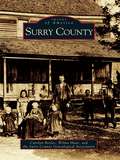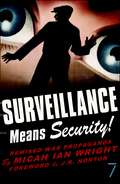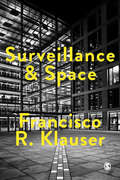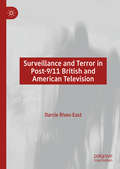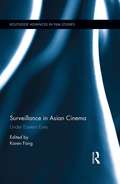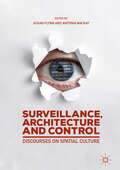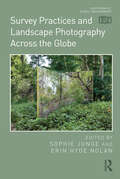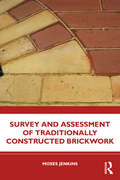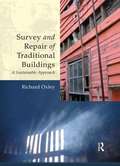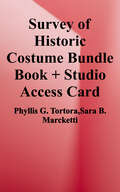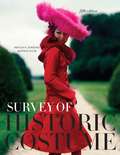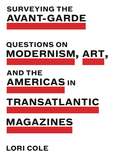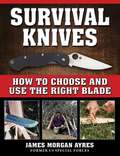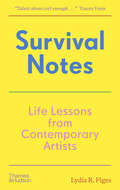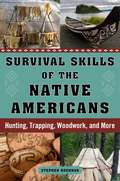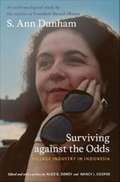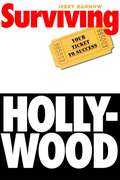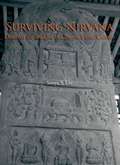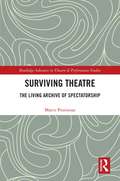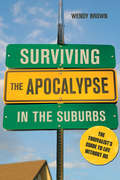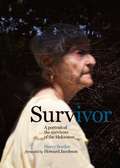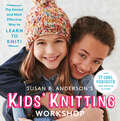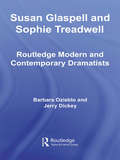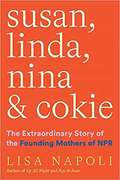- Table View
- List View
Surry County
by Wilma Hiatt Surry County Genealogical Association Carolyn BoylesFounded in 1771 from parts of Rowan County, Surry County possesses a special charm and an engaging history in the northwest corner of the Tar Heel State--a heritage famous for rolling hills, autumn festivals, and the birthplace of "Mayberry," which attracts countless tourists and visitors each season to the county's 15 townships. This volume, containing over 200 black-and-white images, transports readers into the Surry County of yesteryear, a time when the county's unpaved roads echoed with a cadence of noisy wagons matched with the sounds of early automobiles. Through these historic photographs, readers will explore the landscape of a bygone era, from the 1880s through the 1930s, and travel through each of the county's townships: Franklin, Bryan, Elkin, Marsh, Dobson, Stewarts Creek, Mount Airy, Eldora, Rockford, Siloam, Shoals, Pilot, Long Hill, Westfield, and South Westfield. Surry County uncovers the personal side of the county's history by touching upon many elements of everyday life, from family gatherings, church services, various occupations, daily work on the farm, early rural schoolhouses, and people at play. These scenes serve as fitting testimony to Surry Countians' sheer will and determination to carve successful and lasting communities into this beautiful setting.
Surveillance Means Security: Remixed War Propaganda
by J. R. Norton Micah Ian WrightSubversive and incendiary, this full-color poster book reworks classic war propaganda to comment on corporate corruption, domestic spying, election fraud, gay marriage, blind patriotism, the "War on Terror," and surveillance in America today.With laughs and jeers, Wright's distinctive artwork and astute political commentary offers timely and clever insight into the state of post-9/11 America. Surveillance Means Security! is the hilarious follow-up to Wright's previous books of reworked propaganda posters, You Back The Attack! We'll Bomb Who We Want! and If You're Not A Terrorist ...Then Stop Asking Questions.
Surveillance and Space (Society and Space)
by Francisco KlauserThe digital age is also a surveillance age. Today, computerized systems protect and manage our everyday life; the increasing number of surveillance cameras in public places, the computerized loyalty systems of the retail sector, geo-localized smart-phone applications, or smart traffic and navigation systems. Surveillance is nothing fundamentally new, and yet more and more questions are being asked: Who monitors whom, and how and why? How do surveillance techniques affect socio-spatial practices and relationships? How do they shape the fabrics of our cities, our mobilities, the spaces of the everyday? And what are the implications in terms of border control and the exercise of political power? Surveillance and Space responds to these modern questions by exploring the complex and varied interactions between surveillance and space. In doing so, the book also advances a programmatic reflection on the very possibility of a ‘political geography of surveillance’.
Surveillance and Terror in Post-9/11 British and American Television
by Darcie Rives-EastThis interdisciplinary study examines how state surveillance has preoccupied British and American television series in the twenty years since 9/11. Surveillance and Terror in Post-9/11 British and American Television illuminates how the U.S. and U.K., bound by an historical, cultural, and television partnership, have broadcast numerous programs centred on three state surveillance apparatuses tasked with protecting us from terrorism and criminal activity: the prison, the police, and the national intelligence agency. Drawing from a range of case studies, such as Sherlock, Orange is the New Black and The Night Manager, this book discusses how television allows viewers, writers, and producers to articulate fears about an increased erosion of privacy and civil liberties following 9/11, while simultaneously expressing a desire for a preventative mechanism that can stop such events occurring in the future. However, these concerns and desires are not new; encompassing surveillance narratives both past and present, this book demonstrates how television today builds on earlier narratives about panoptic power to construct our present understanding of government surveillance.
Surveillance in Asian Cinema: Under Eastern Eyes (Routledge Advances in Film Studies)
by Karen FangCritical theory and popular wisdom are rife with images of surveillance as an intrusive, repressive practice often suggestively attributed to eastern powers and opposed to western liberalism. Hollywood-dominated global media has long promulgated a geopoliticized east-west axis of freedom vs. control. This book focuses on Asian and Asia-based films and cinematic traditions obscured by lopsided western hegemonic discourse and—more specifically—probes these films’ treatments of a phenomenon that western film often portrays with neo-orientalist hysteria. Exploring recent and historical movies made in post-social and anti-Communist societies such as China, Hong Kong, Taiwan, Vietnam and South Korea, the book picks up on the political and economic concerns implicitly underlying Sinophobic and anti-Communist Asian images in Hollywood films while also considering how these societies and states depict the issues of centralization, militarization and technological innovation so often figured as distinctive of the difference between eastern despotism and western liberalism.
Surveillance, Architecture and Control: Discourses on Spatial Culture
by Susan Flynn Antonia MackayThis edited collection examines the culture of surveillance as it is expressed in the built environment. Expanding on discussions from previous collections; Spaces of Surveillance: States and Selves (2017) and Surveillance, Race, Culture (2018), this book seeks to explore instances of surveillance within and around specific architectural entities, both historical and fictitious, buildings with specific social purposes and those existing in fiction, film, photography, performance and art. Providing new readings of, and expanding on Foucault’s work on the panopticon, these essays examine the role of surveillance via disparate fields of enquiry, such as the humanities, social sciences, technological studies, design and environmental disciplines. Surveillance, Architecture and Control seeks to engender new debates about the nature of the surveilled environment through detailed analyses of architectural structures and spaces; examining how cultural, geographical and built space buttress and produce power relations. The various essays address the ongoing fascination with contemporary notions of surveillance and control.
Survey Practices and Landscape Photography Across the Globe (Photography, Place, Environment)
by Sophie Junge Erin Hyde NolanThis edited volume considers the many ways in which landscape (seen and unseen) is fundamental to placemaking, colonial settlement, and identity formation. Collectively, the book’s authors map a constellation of interlocking photographic histories and survey practices, decentering Europe as the origin of camera-based surveillance. The volume charts a conversation across continents - connecting Europe, Africa, the Arab World, Asia, and the Americas. It does not segregate places, histories, and traditions but rather puts them in dialogue with one another, establishing solidarity across ever-shifting national, linguistic, racial, religious, and ethnic. Refusing the neat organization of survey photographs into national or imperial narratives, these essays celebrate the messy, cross-cultural reverberations of landscape over the past 170 years. Considering the visual, social, and historical networks in which these images circulate, this anthology connects the many entangled and political histories of photography in order to reframe survey practices and the multidimensionality of landscape as an international phenomenon. This book will be of interest to scholars in art history, history of photography, and landscape history.
Survey and Assessment of Traditionally Constructed Brickwork
by Moses JenkinsThe principal aim of this book is to improve the practice of surveying traditionally constructed brickwork. It aims to ensure that those who have a cause to survey buildings constructed of traditional (pre-1919) brickwork have a well-developed, clear methodology for undertaking effective, comprehensive surveys. The book will help readers gain the proper level of knowledge, expertise and skill to be able to survey these buildings correctly; to recognise not just defects within the brickwork itself, but also, crucially, the cause of these defects. Experienced author Moses Jenkins presents a clear and concise methodology for the survey of brickwork in existing buildings with coverage including: identifying repair needs understanding the cause of decay within brickwork ascertaining the age and significance of traditionally constructed brickwork, and identifying significant technical and decorative features. Despite the extensive use of traditionally constructed brick worldwide, the knowledge and expertise to properly survey buildings of this type has not, to date, been laid out in a reliable and methodical way. This book addresses this deficiency and provides an invaluable resource to all those who survey and assess buildings constructed of brickwork. This includes building professionals such as architects, surveyors, engineers and those working in building conservation, but also construction managers and students studying built environment disciplines.
Survey and Repair of Traditional Buildings
by Richard OxleyUnderstanding the unique requirements of traditional buildings is crucial to providing appropriate guidance on their care and repair. This book will help practitioners identify the particular issues relating to older buildings and the problems they may encounter when surveying and repairing them. With the use of examples, the author provides invaluable information on how traditional buildings perform, emphasizing the need for a sensitive and sustainable approach which also takes account of the specific needs of the building. The book examines all aspects to be included in any assessment for survey and repair, and points out in detail the potential pitfalls. It also explores the controversial issues surrounding the treatment of damp and timber decay, advocating solutions that are appropriate to older buildings rather than using standard, often damaging, methods of treatment. The extensive case studies not only illustrate good conservation in practice but also how projects can go badly wrong, and how mistakes could have been avoided. This title explores the causes of movement and the actions required. It advises on alternatives to chemical treatment for damp and timber decay. It provides fully illustrated case studies with numerous photographs. It emphasizes a sustainable approach to conservation. It outlines the key legislation issues. It includes the Historic Buildings Prosecution Fines Database and other useful appendices.
Survey of Historic Costume
by Phyllis G. Tortora Sara B. MarckettiLearn about Western dress from the ancient world to today. Each chapter shows you the social, cross-cultural, environmental, geographic, and artistic influences on what people wore. More than 600 images help you to recognize recurring themes and concepts and understand the role of dress from a diverse, global perspective. <p><p>The book covers each decade, from the 1920s to the present, in separate chapters to help you keep track of the changes in modern fashion. Learning Objectives, Key Terms, Discussion Questions and Exercises, and a Glossary help you master concepts.
Survey of Historic Costume (5th Edition)
by Keith Eubank Phyllis G. TortoraUpdated and redesigned with full-color illustrations, this authoritative text on costume history provides a complete chronology of Western dress that discusses the fashion of each era within its historical, cultural, and economic contexts.
Surveying the Avant-Garde: Questions on Modernism, Art, and the Americas in Transatlantic Magazines (Refiguring Modernism #26)
by Lori ColeSurveying the Avant-Garde examines the art and literature of the Americas in the early twentieth century through the lens of the questionnaire, a genre as central as the manifesto to the history of the avant-garde.Questions such as “How do you imagine Latin America?” and “What should American art be?” issued by avant-garde magazines like Imán, a Latin American periodical based in Paris, and Cuba’s Revista de Avance demonstrate how editors, writers, and readers all grappled with the concept of “America,” particularly in relationship to Europe, and how the questionnaire became a structuring device for reflecting on their national and aesthetic identities in print. Through an analysis of these questionnaires and their responses, Lori Cole reveals how ideas like “American art,” as well as “modernism” and “avant-garde,” were debated at the very moment of their development and consolidation. Unlike a manifesto, whose signatories align with a single polemical text, the questionnaire produces a patchwork of responses, providing a composite and sometimes fractured portrait of a community. Such responses yield a self-reflexive history of the era as told by its protagonists, which include figures such as Gertrude Stein, Alfred Stieglitz, Jean Toomer, F. T. Marinetti, Diego Rivera, and Jorge Luis Borges.The book traces a genealogy of the genre from the Renaissance paragone, or “comparison of the arts,” through the rise of enquêtes in the late nineteenth century, up to the contemporary questionnaire, which proliferates in art magazines today. By analyzing a selection of surveys issued across the Atlantic, Cole indicates how they helped shape artists’ and writers’ understanding of themselves and their place in the world.Derived from extensive archival research, this book reorients our understanding of modernism as both hemispheric and transatlantic by narrating how the artists and writers of the period engaged in aesthetic debates that informed and propelled print communities in Europe, the United States, and Latin America. Scholars of modernism and the avant-garde will welcome Cole’s original and compellingly crafted work.
Surveying the Avant-Garde: Questions on Modernism, Art, and the Americas in Transatlantic Magazines (Refiguring Modernism)
by Lori ColeSurveying the Avant-Garde examines the art and literature of the Americas in the early twentieth century through the lens of the questionnaire, a genre as central as the manifesto to the history of the avant-garde.Questions such as “How do you imagine Latin America?” and “What should American art be?” issued by avant-garde magazines like Imán, a Latin American periodical based in Paris, and Cuba’s Revista de Avance demonstrate how editors, writers, and readers all grappled with the concept of “America,” particularly in relationship to Europe, and how the questionnaire became a structuring device for reflecting on their national and aesthetic identities in print. Through an analysis of these questionnaires and their responses, Lori Cole reveals how ideas like “American art,” as well as “modernism” and “avant-garde,” were debated at the very moment of their development and consolidation. Unlike a manifesto, whose signatories align with a single polemical text, the questionnaire produces a patchwork of responses, providing a composite and sometimes fractured portrait of a community. Such responses yield a self-reflexive history of the era as told by its protagonists, which include figures such as Gertrude Stein, Alfred Stieglitz, Jean Toomer, F. T. Marinetti, Diego Rivera, and Jorge Luis Borges.The book traces a genealogy of the genre from the Renaissance paragone, or “comparison of the arts,” through the rise of enquêtes in the late nineteenth century, up to the contemporary questionnaire, which proliferates in art magazines today. By analyzing a selection of surveys issued across the Atlantic, Cole indicates how they helped shape artists’ and writers’ understanding of themselves and their place in the world.Based on extensive archival research, this book reorients our understanding of modernism as both hemispheric and transatlantic by narrating how the artists and writers of the period engaged in aesthetic debates that informed and propelled print communities in Europe, the United States, and Latin America. Scholars of modernism and the avant-garde will welcome Cole’s original and compellingly crafted work.
Survival Knives: How to Choose and Use the Right Blade
by James Morgan AyresSome survival guides explain the basics of how to make primitive tools. But do you know how to actually successful hunt with spear, throwing stick, bola, or primitive bow? Making tools that you do not know how to hunt with will not get you to meat. If you’re hunting with primitive weapons, especially crude survival weapons you’ve made in the field under actual survival conditions, you must adapt your strategy to the weapons available or go hungry. Author James M. Ayres grew up in the Midwest hunting squirrels, rabbits, and other small game with bows, spears, atlatls, and bolas he made myself. He has hunted with bow, spear, net, and other primitive weapons with the Lacandon in Yucatán, the Igorots in the Philippines, the K’iche’ in Guatemala, the Sasak in Indonesia, and others. In Survival Knives, he shares his knowledge so you, too, can survive using such tools and weapons. It’s not enough to have a knife and know how to make basic hunting weapons. That’s craftsmanship—not survival. Nor is it enough simply to have a knife when trapped in an emergency situation, like a collapsed building. You need to know how to conserve your knife and use it properly to escape so that it will not break and you are not injured. Learn how to use survival knives, and how to use the tools and weapons you can make with the knife—not only in wilderness, but also in urban areas, foreign countries, and disaster zones such as earthquakes, floods, fires, and civil insurrections.
Survival Notes: Life Lessons from Contemporary Artists
by Lydia Rachel FigesWeaving artists' reflections and anecdotes with their invaluable words of advice to aspiring creatives, this inspiring book explores the practical realities of the art world and demystifies the route to professional success. Survival Notes is an inspiring narrative weaving artists' reflections on success with advice to aspiring creatives. Featuring direct quotes and exclusive interviews with internationally acclaimed artists such as Anish Kapoor, Shirin Neshat, Tracey Emin, Jesse Darling, and Shahzia Sikander, this book offers authoritative counsel on how to thrive in a highly competitive art world as well as thoughtful insights on what it means to be an artist in the twenty-first century. Nine thematic chapters offer essential guidance on how to negotiate the practical realities of artmaking, with discussions relating to education, self-discipline, gallery representation, mental wellbeing, mentorship and more. In a climate where emerging creatives feel less empowered than ever, Lydia R. Figes provides a hopeful message about perseverance and perspective, while questioning whether the advice given by established practitioners can still be applied today.
Survival Skills of the Native Americans: Hunting, Trapping, Woodwork, and More
by Stephen BrennanBecome a pro at living and thriving off the land.Survival Skills of the Native Americans is a fascinating, practical guide to the techniques that have made the indigenous people of North America revered for their mastery of the wilderness. Readers can replicate outdoor living by trying a hand at making rafts and canoes, constructing tools, and living off the land.Learn key skills like:Building a strong campfireLearning to hunt and butcher your meatsCreating a safe and solid shelterAnd much more!Whether you're an avid outdoorsman or a novice hiker, Survival Skills of the Native Americans is your handbook to not simply surviving the outdoors, but flourishing. The know-how of the Native Americans is unique and popular, admired by young people, historians, and those with a special interest in living off the land. Native Americans have lived outdoors for ages, and now you can be successful, too, with the skills, tips, and tricks included in this handy manual.Skyhorse Publishing is proud to publish a broad range of books for hunters and firearms enthusiasts. We publish books about shotguns, rifles, handguns, target shooting, gun collecting, self-defense, archery, ammunition, knives, gunsmithing, gun repair, and wilderness survival. We publish books on deer hunting, big game hunting, small game hunting, wing shooting, turkey hunting, deer stands, duck blinds, bowhunting, wing shooting, hunting dogs, and more. While not every title we publish becomes a New York Times bestseller or a national bestseller, we are committed to publishing books on subjects that are sometimes overlooked by other publishers and to authors whose work might not otherwise find a home.
Surviving Against the Odds: Village Industry in Indonesia
by S. Ann DunhamRead the foreword by Mara Soetoro-Ng President Barack Obama's mother, S. Ann Dunham, was an economic anthropologist and rural development consultant who worked in several countries including Indonesia. Dunham received her doctorate in 1992. She died in 1995, at the age of 52, before having the opportunity to revise her dissertation for publication, as she had planned. Dunham's dissertation adviser Alice G. Dewey and her fellow graduate student Nancy I. Cooper undertook the revisions at the request of Dunham's daughter, Maya Soetoro-Ng. The result is Surviving against the Odds, a book based on Dunham's research over a period of fourteen years among the rural metalworkers of Java, the island home to nearly half Indonesia's population. Surviving against the Odds reflects Dunham's commitment to helping small-scale village industries survive; her pragmatic, non-ideological approach to research and problem solving; and her impressive command of history, economic data, and development policy. Along with photographs of Dunham, the book includes many pictures taken by her in Indonesia. After Dunham married Lolo Soetoro in 1967, she and her six-year-old son, Barack Obama, moved from Hawai'i to Soetoro's home in Jakarta, where Maya Soetoro was born three years later. Barack returned to Hawai'i to attend school in 1971. Dedicated to Dunham's mother Madelyn, her adviser Alice, and "Barack and Maya, who seldom complained when their mother was in the field," Surviving against the Odds centers on the metalworking industries in the Javanese village of Kajar. Focusing attention on the small rural industries overlooked by many scholars, Dunham argued that wet-rice cultivation was not the only viable economic activity in rural Southeast Asia. Surviving against the Odds includes a preface by the editors, Alice G. Dewey and Nancy I. Cooper, and a foreword by her daughter Maya Soetoro-Ng, each of which discusses Dunham and her career. In his afterword, the anthropologist and Indonesianist Robert W. Hefner explores the content of Surviving against the Odds, its relation to anthropology when it was researched and written, and its continuing relevance today.
Surviving Hollywood: Your Ticket to Success
by Jerry RannowFilled with dozens of personal anecdotes, musings, and warnings from writers, producers, actors, and directors who have been there, Surviving Hollywood: Your Ticket to Success provides all the real-life tools you need for protecting your personal well-being in an unstable and sometimes unscrupulous industry. Readers will discover sage advice for keeping their spirits up despite constant rejection, weathering long periods of unemployment, maintaining a stable marriage and family life in an unstable business, keeping the faith in the midst of lies and deceit, and much more. Special sections address such topics as the dangers child actors face and how to deal with egomaniacs without becoming one.
Surviving Nirvana
by Sonya S. LeeThe Buddha's nirvana marks the end of the life of a great spiritual figure and the beginning of Buddhism as a world religion. Surviving Nirvana is the first book in the English language to examine how this historic moment was represented and received in t
Surviving Theatre: The Living Archive of Spectatorship (Routledge Advances in Theatre & Performance Studies)
by Marco PustianazWritten soon before and in the middle of the Covid-19 pandemic when theatre ground to a halt and spectatorship was suspended, this book takes stock of spectatorship as theatre’s living archive and affirms its value in the midst of the present crisis. Drawing from a manifold affective archive of performances and installations by Marina Abramović, Ron Athey, Forced Entertainment, Socìetas Raffaello Sanzio, Blast Theory, LIGNA, Doris Salcedo, Graeme Miller, Lenz Rifrazioni, Cristina Rizzo ..., and expanding on the work of many theorists and scholars like Roland Barthes and Jacques Rancière, Giorgio Agamben and Alain Badiou, Nicholas Ridout and Alan Read, among others, the book focuses on the spectator as the subject, rather than the object, of investigation. This is the right time to remember their secret power and theorise their collective time in the theatre. This book is an archive of their adventure and a manifesto rooted in their potentiality. It boldly posits the spectator as the inaugurator of theatre, the surplus that survives it. The book will be of great interest to spectators all and sundry, to scholars and students of theatre and performance studies, of spectatorship and politics.
Surviving the Apocalypse in the Suburbs
by Wendy BrownBased on the premise that we have 21 days before we lose our modern conveniences, Surviving the Apocalypse in the Suburbs is packed with practical solutions for becoming more self-reliant and transitioning to a lower energy lifestyle. From shelter to livestock to transportation to tools, this is the ultimate guide to simplifying your lifestyle while reducing your dependence on oil.
Survivor: A portrait of the survivors of the Holocaust
by Harry Borden'A masterpiece and deeply moving' - Alain de Botton'A wonderful piece of work' - Lynn Barber"...something really to behold, a substantial project of some real depth and authority. By flicking through the pages you can sense the amount of research, patience and hard work that has been invested. The portraits, as always with Borden are simple, effective and very telling." - Martin ParrSurvivor is a unique and powerful testimony of what it is to live with memories of the Holocaust.Over the course of five years, acclaimed photographer Harry Borden has travelled the globe photographing survivors of the Holocaust. The people featured vary in age, gender and nationality, but are all tied together by their experience and survival of one of the darkest moments in human history.Each photograph is accompanied by a handwritten note from the sitter, ranging from poems, to memories, to hopes for the future, creating a strong sense of intimacy between sitter and reader. At the end of the book is a section providing more information about the person in each portrait, and about how and what they survived, together with the historical context of the events they lived through. Thought-provoking and touching, this book conveys the dignity and humanity of each subject's character.
Susan B. Anderson's Kids' Knitting Workshop: The Easiest and Most Effective Way to Learn to Knit!
by Susan B. AndersonBeloved knitting instructor Susan B. Anderson presents her first book targeted at a young audience. This accessible introduction to knitting in the round includes easy-to-follow illustrated tutorials on techniques from casting on and binding off to joining colors to make stripes, and 17 progressively challenging knitting projects—beginning with simple infinity scarves and hats and building to supersweet toys and decor. Step-by-step text and photographs that kids can read and follow on their own mean they will be knitting independently in no time! Also included is a chapter on stocking your toolbox and sourcing yarn; plus advice on starting a knitting group, connecting with local knitting communities, charity knitting, and more.
Susan Glaspell and Sophie Treadwell (Routledge Modern and Contemporary Dramatists)
by Barbara Ozieblo Jerry DickeySusan Glaspell and Sophie Treadwell presents critical introductions to two of the most significant American dramatists of the early twentieth century. Glaspell and Treadwell led American Theatre from outdated melodrama to the experimentation of great European playwrights like Ibsen, Strindberg and Shaw. This is the first book to deal with Glaspell and Treadwell’s plays from a theatrical, rather than literary, perspective, and presents a comprehensive overview of their work from lesser known plays to seminal productions of Trifles and Machinal. Although each woman pursued her own themes, subjects and manner of stage production, this shared volume underscores the theatrical and cultural conditions influencing female playwrights in modern America.
Susan, Linda, Nina, And Cokie: The Extraordinary Story Of The Founding Mothers Of NPR
by Lisa NapoliIn the years after the Civil Rights Act of 1964, women in the workplace still found themselves relegated to secretarial positions or locked out of jobs entirely. This was especially true in the news business, a backwater of male chauvinism where a woman might be lucky to get a foothold on the “women’s pages.” But when a pioneering nonprofit called National Public Radio came along in the 1970s, and the door to serious journalism opened a crack, four remarkable women came along and blew it off the hinges. Susan, Linda, Nina, and Cokie is journalist Lisa Napoli’s captivating account of these four women, their deep and enduring friendships, and the trail they blazed to becoming icons. They had radically different stories. Cokie Roberts was born into a political dynasty, roamed the halls of Congress as a child, and felt a tug toward public service. Susan Stamberg, who had lived in India with her husband who worked for the State Department, was the first woman to anchor a nightly news program and pressed for accommodations to balance work and home life. Linda Wertheimer, the daughter of shopkeepers in New Mexico, fought her way to a scholarship and a spot on-air. And Nina Totenberg, the network's legal affairs correspondent, invented a new way to cover the Supreme Court. Based on extensive interviews and calling on the author’s deep connections in news and public radio, Susan, Linda, Nina, and Cokie will be as beguiling and sharp as its formidable subjects.
